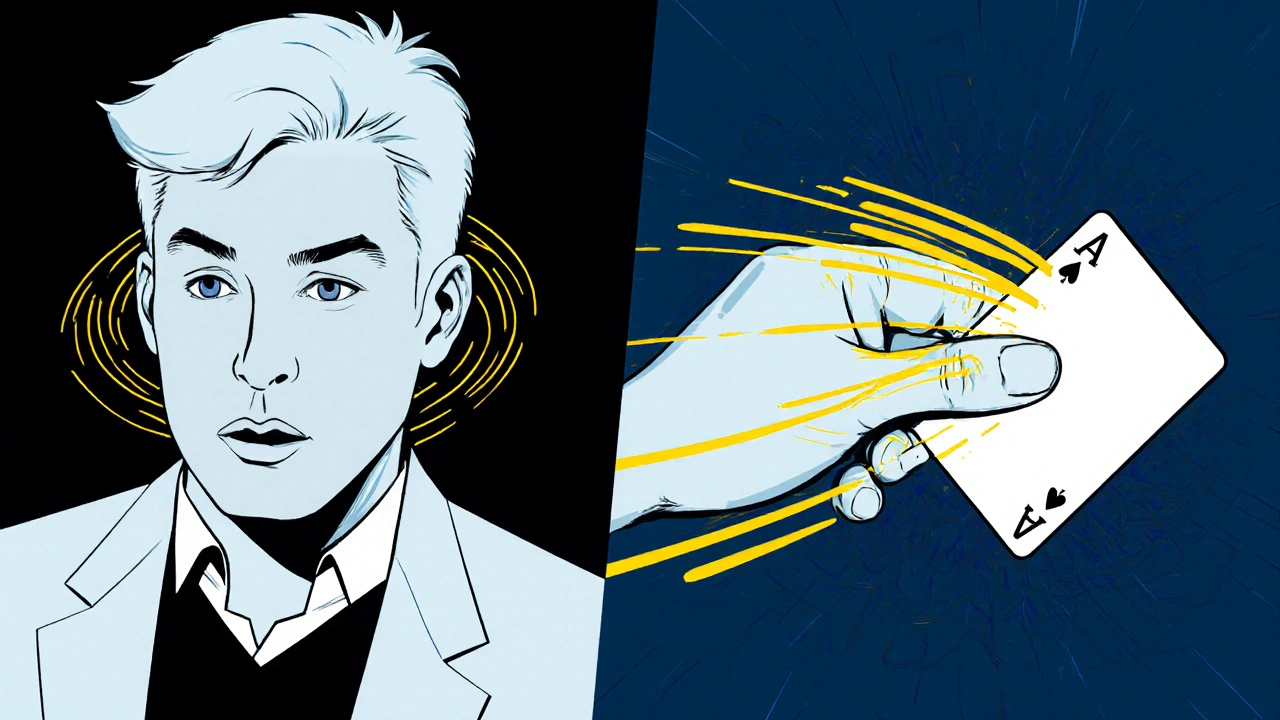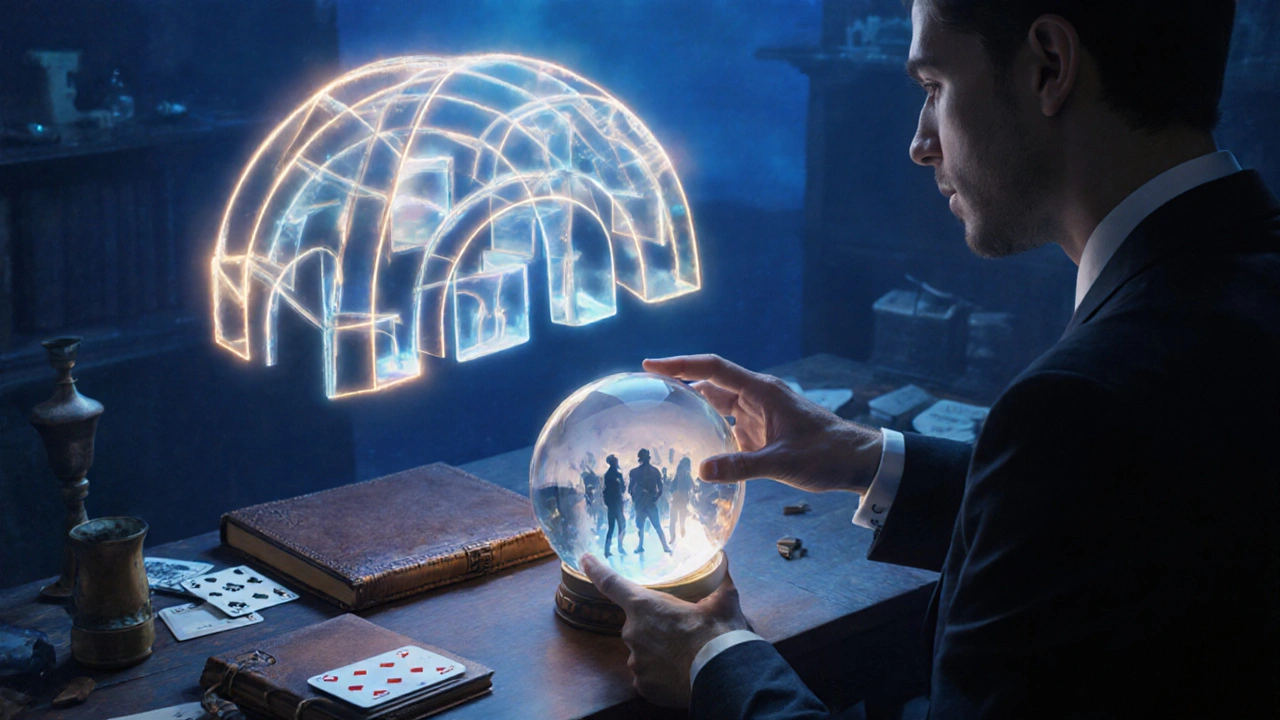Forced Choice Calculator
How Mentalists Guide Your Choices
Most people naturally gravitate toward certain numbers when asked to "think of any number." This tool simulates the psychological patterns mentalists exploit to create the illusion of mind reading.
Your Selection Analysis
Enter a number to see how mentalists predict your choice...
When you see a performer name a card you were just thinking about, you wonder what hidden power is at play. The answer lies in Mentalism a performance art that creates the illusion of mind‑reading, prediction, and influence using psychological techniques. If you’re chasing mentalism secrets, this guide shows why they work and how you can start practicing them today.
How Mentalism Works
Mentalism isn’t magic in the sense of pulling a rabbit from a hat. It leans on subtle cues, suggestion, and a deep understanding of how the brain processes information. A mentalist builds a story in the audience’s mind, then guides their thoughts toward a predictable outcome. The result feels like pure mind‑reading, but it’s actually a carefully crafted psychological script.
Core Techniques Behind the Illusion
Every solid routine relies on a handful of core methods. Below are the most common, each explained with everyday examples.
- Cold Reading a set of observational tricks that make it appear the performer knows personal details about a stranger. Think of a friend who instantly says, “You’re a planner, but you sometimes act on impulse.” That line combines generic statements with body‑language clues.
- Misdirection the deliberate redirection of audience attention away from the method. A classic example: while the audience watches a dramatic hand gesture, a subtle finger tap swaps two cards unnoticed.
- Neurolinguistic Programming a communication model that uses language patterns to influence subconscious decisions. Phrases like “When you think of the color blue, you might feel a cool calmness” can prime a choice without the audience realizing it.
- Subconscious Cueing the subtle use of gestures, eye contact, or tone to steer thoughts. A brief pause before asking a question often makes the listener fill the silence with the answer you want.
- Dual Reality creating two different experiences for the audience and a selected participant. The crowd sees a random shuffle, while the participant is silently guided to a specific card.
- Memory Feat showcasing an extraordinary recall ability, often supported by mnemonic systems. Remembering a shuffled deck order in seconds is impressive, but the real secret is a structured memory palace.
Psychological Foundations
The techniques above aren’t random tricks; they rest on well‑studied cognitive phenomena. For instance, the "Barnum effect" explains why vague statements feel personal. "Confirmation bias" leads audiences to remember the hits and forget the misses. Understanding these biases lets a mentalist craft narratives that stick.

Popular Mentalism Tricks Decoded
Below are three classic effects broken down to show the hidden layers.
- “Think of a number, any number.” The performer uses a forced‑choice routine. By subtly emphasizing “any” and then guiding the spectator’s eye to a hidden grid, the mentalist steers most people to pick 7, 13, or 42. The few who don’t are given a quick “cancellation” narrative to keep the illusion intact.
- “The Book Test.” A spectator selects a word from a random page. Behind the scenes, the mentalist pre‑marks a set of “key words” on each page and uses a memorized “probability matrix” to guess the word most likely chosen. The trick feels like genuine mind‑reading because the book is genuinely random to the audience.
- “Predicting the Future.” Before the show, a sealed envelope contains a prediction. During the act, the performer guides the audience through a series of choices that converge on the pre‑written outcome. This is a blend of "forced choice" and "dual reality".
Building Your Own Routine
Want to try mentalism yourself? Start with a simple three‑step framework.
- Choose a core effect. Pick something you can rehearse daily-like a number‑guessing routine.
- Layer a psychological hook. Add a brief story that creates emotional investment. Stories trigger the brain’s mirror neurons, making the effect feel more personal.
- Practice misdirection and pacing. Record yourself to see where the audience’s attention drifts. Adjust gestures and pauses until the method stays hidden.
Keep a notebook of observations. Note which phrasing triggers the strongest responses and refine the script weekly.

Mistakes to Avoid
- Over‑explaining the method. Simplicity sells; the audience needs “wow,” not a lecture.
- Relying on gimmicky props. The power lies in the mind, not the gadget.
- Ignoring audience feedback. If a participant looks confused, pause and adjust the narrative.
Resources & Next Steps
Ready to dive deeper? Here are proven resources that many professional mentalists swear by.
- The Art of Mentalism by Bob Cassidy - a comprehensive guide covering theory and practice.
- Psychological Subtleties - a video series focusing on body‑language cues.
- Local meetup groups in Bend, OR - practicing with peers accelerates learning.
Remember, mentalism is a skill, not a supernatural gift. Consistent practice, an eye for human behavior, and a willingness to refine your story will unlock the secret behind every baffling performance.
| Aspect | Mentalism | Stage Magic | Hypnosis |
|---|---|---|---|
| Primary focus | Mind influence & perception | Visual spectacle & illusion | Altered state of consciousness |
| Typical setting | Intimate stage or close‑up | Large theater or street | Therapeutic or entertainment venue |
| Key technique | Cold Reading & suggestion | Sleight‑of‑hand & gimmicks | Induction & deep suggestion |
Frequently Asked Questions
Can anyone learn mentalism, or is it an innate talent?
Anyone can learn the core techniques. Like any performance art, success comes from study, practice, and feedback-not from a mysterious gift.
Is mentalism the same as hypnosis?
They share a focus on the mind, but mentalism relies on perception tricks and suggestion, while hypnosis aims to induce a trance state for therapeutic or entertainment purposes.
What ethical lines should a mentalist respect?
Never claim real psychic powers, avoid exploiting vulnerable people, and always obtain consent for any deeply personal revelations.
How much time should I dedicate to practice each week?
Consistent short sessions work best. Aim for 30‑45 minutes daily focusing on one technique, then a weekly 2‑hour rehearsal of a full routine.
Which books are essential for beginners?
Start with The Art of Mentalism by Bob Cassidy, then explore Psychological Subtleties by Banachek for deeper cueing strategies.


Rajashree Iyer
October 13, 2025 AT 17:34In the quiet corridors of the mind, thoughts drift like ancient ships on a foggy sea. With every subtle glance, a mentalist steers unseen currents, guiding the audience toward a destiny they never imagined. The art is a dance of suggestion, a whispered promise that the soul can read the future. Each gesture is a thread, woven into the tapestry of perception, and the viewer believes they have witnessed true mind‑reading. Thus, the miracle is not magic, but the beautiful illusion of being understood.
Parth Haz
October 21, 2025 AT 15:51It is wonderful to see a clear breakdown of the mentalism toolbox. I encourage anyone interested to start with one small technique, such as cold reading, and practice it daily. Consistency will build confidence and the subtle art of suggestion becomes more natural over time. Remember to keep your language respectful and your intent pure, as the audience’s trust is paramount. Your journey into the mind’s mysteries can begin with a single, focused step.
Vishal Bharadwaj
October 29, 2025 AT 13:08Obviosuly they cheat.
anoushka singh
November 6, 2025 AT 11:25Nice overview, but the real secret is just reading people’s bodies, nothing mystical. The guide feels a bit over‑the‑top for beginners who just want a simple trick. A quick tip: watch how they fold their hands, that gives you a clue. Keep it simple and you’ll look like a pro faster.
Jitendra Singh
November 14, 2025 AT 09:43I appreciate the balanced tone of the article. It acknowledges both the psychological underpinnings and the performance aspects without glorifying deception. As someone who values ethical practice, I think highlighting consent is essential. The advice to keep a notebook resonates with me – documentation is key for improvement. Thanks for sharing this thoughtful perspective.
Madhuri Pujari
November 22, 2025 AT 08:00Wow, what a thorough guide, really! You’ve managed to cram every buzzword – cold reading, NLP, dual reality – into a single post, didn’t you? It’s almost as if you wanted to impress us with jargon rather than teach us something practical. Still, the section on misdirection could use a concrete example, not just a vague “dramatic hand gesture”. And sure, “subconscious cueing” sounds fancy, but it’s basically just paying attention, right? Anyway, keep the fluff to a minimum next time, please.
Sandeepan Gupta
November 30, 2025 AT 06:17Learning mentalism is like building a muscle that you can see and feel.
The foundation is observation, which means paying attention to tiny gestures that most people ignore.
Start each practice session by picking a single cue, such as a subtle eyebrow raise, and train yourself to notice it in everyday conversations.
Record yourself on video and watch the playback; you will be surprised how often your own eyes wander.
When you spot a cue, pause and let the audience fill the gap with their own thoughts, that is the essence of subconscious cueing.
Keep a notebook and log every successful and failed attempt, noting the exact phrasing you used.
Review the log weekly and look for patterns; patterns reveal which words trigger the strongest responses.
Incorporate cold reading techniques gradually, starting with safe statements that apply to most people, such as “You enjoy a quiet evening now and then.”
Then, refine those statements by adding a specific detail you observed, like the color of the shirt they are wearing.
Practice misdirection by rehearsing a harmless gesture, like a hand wave, while secretly shifting a small prop in your other hand.
Timing is crucial; the pause before you ask a question creates a mental space that the brain instinctively wants to fill.
Build a simple routine of three effects – a number guess, a book test, and a prediction – and master each before adding flourishes.
Perform for a small, trusted audience first; ask for honest feedback without revealing your methods.
Adjust your script based on that feedback; flexibility separates a good mentalist from a rigid performer.
Finally, remember that consistency beats talent; a half‑hour of focused practice every day will outpace a weekend of chaotic rehearsal.
Tarun nahata
December 8, 2025 AT 04:34Whoa, mentalism is like painting with words and gestures! Imagine turning a boring dinner party into a mind‑bending adventure where everyone gasps, “How did they know?” That burst of color in a routine – a sudden pause, a bright smile – can make the whole crowd light up. Keep your scripts vivid, your timing snappy, and let the audience ride the wave of wonder. You’ll be the spark that ignites the room’s imagination.
Aryan Jain
December 16, 2025 AT 02:51Sure, it all looks like fun, but have you considered who’s really pulling the strings? Every trick is a tiny experiment in control, a way to test how easily we hand over our thoughts. It’s not just entertainment; it’s a glimpse into how powerful suggestion can be when you know where to look.